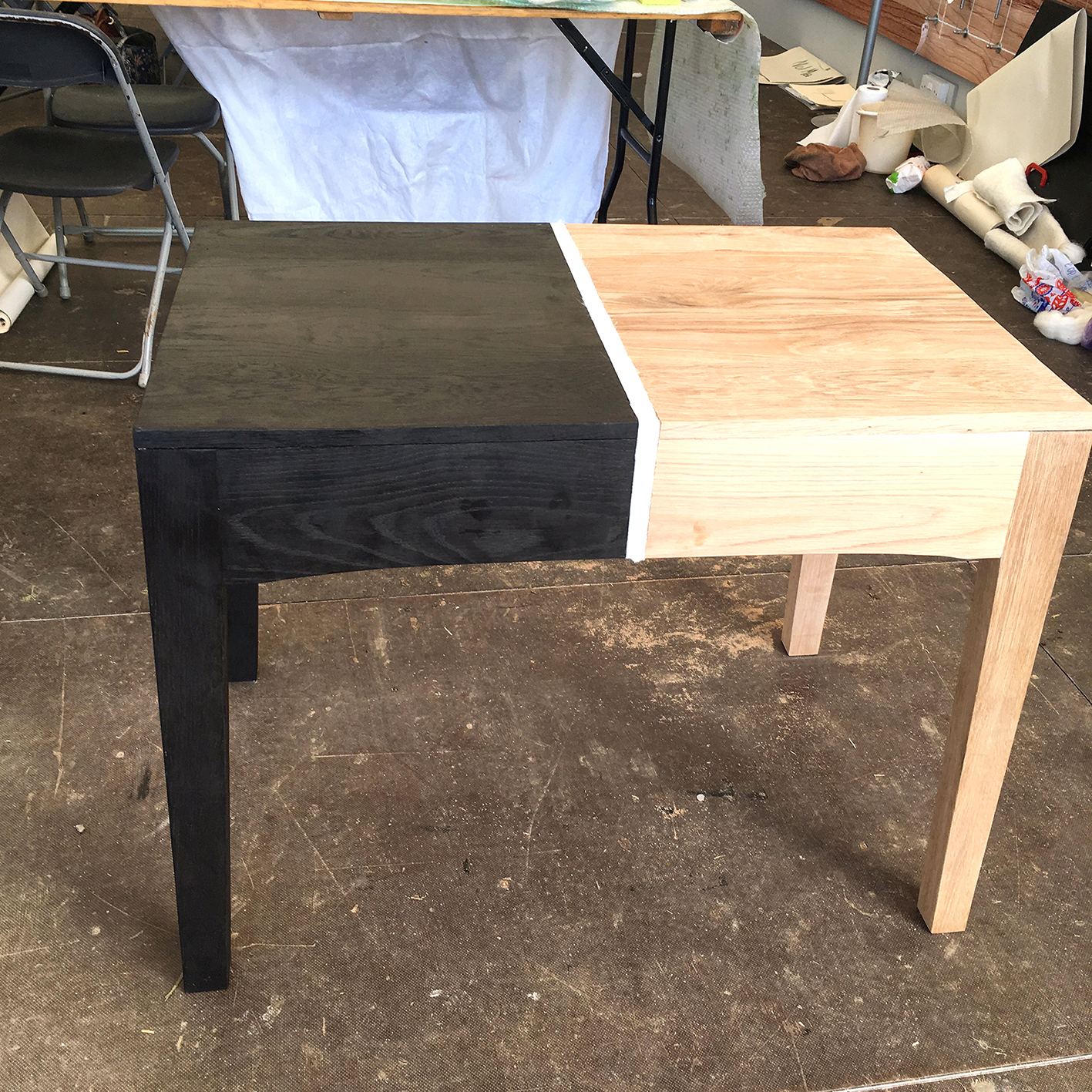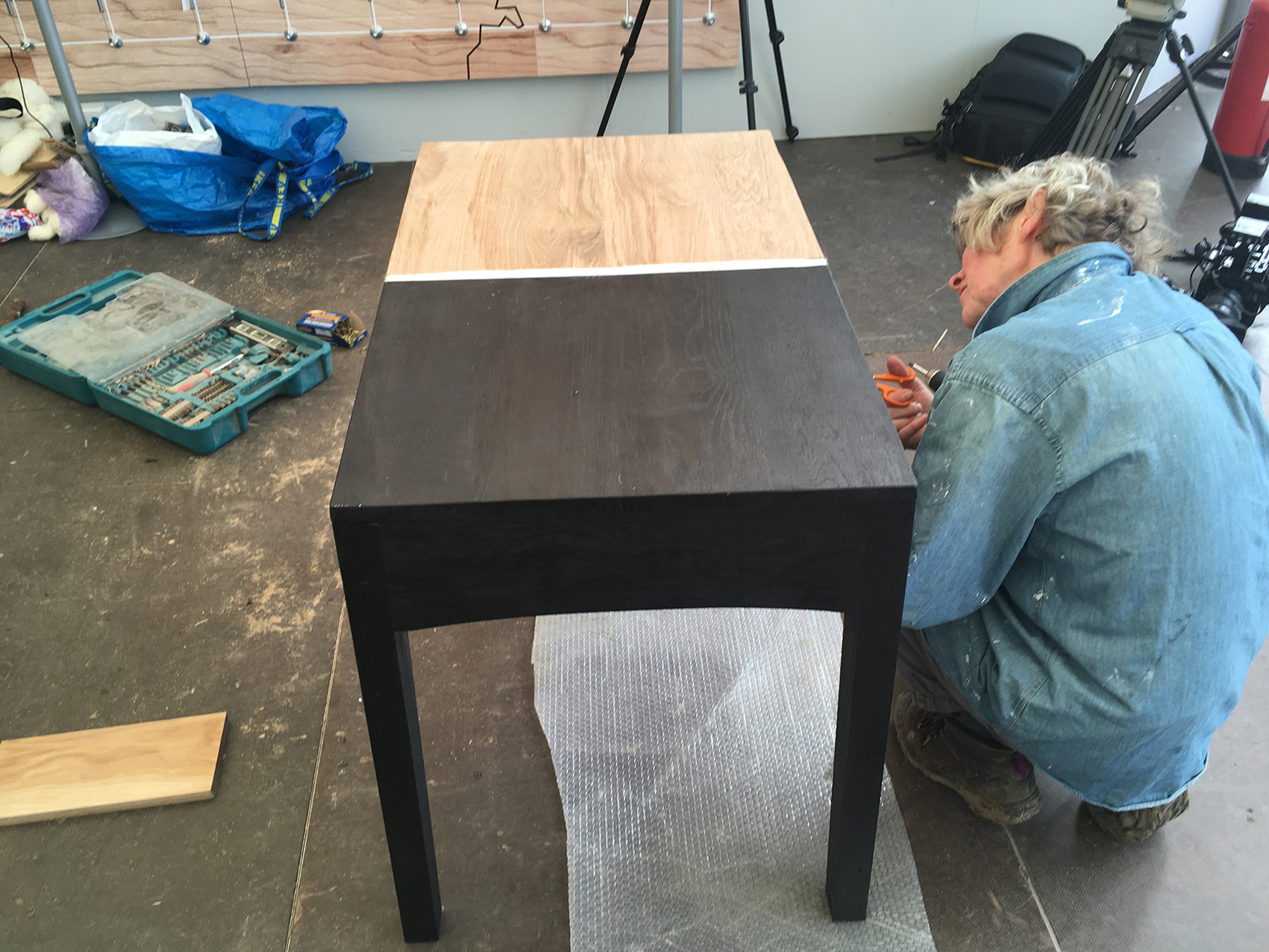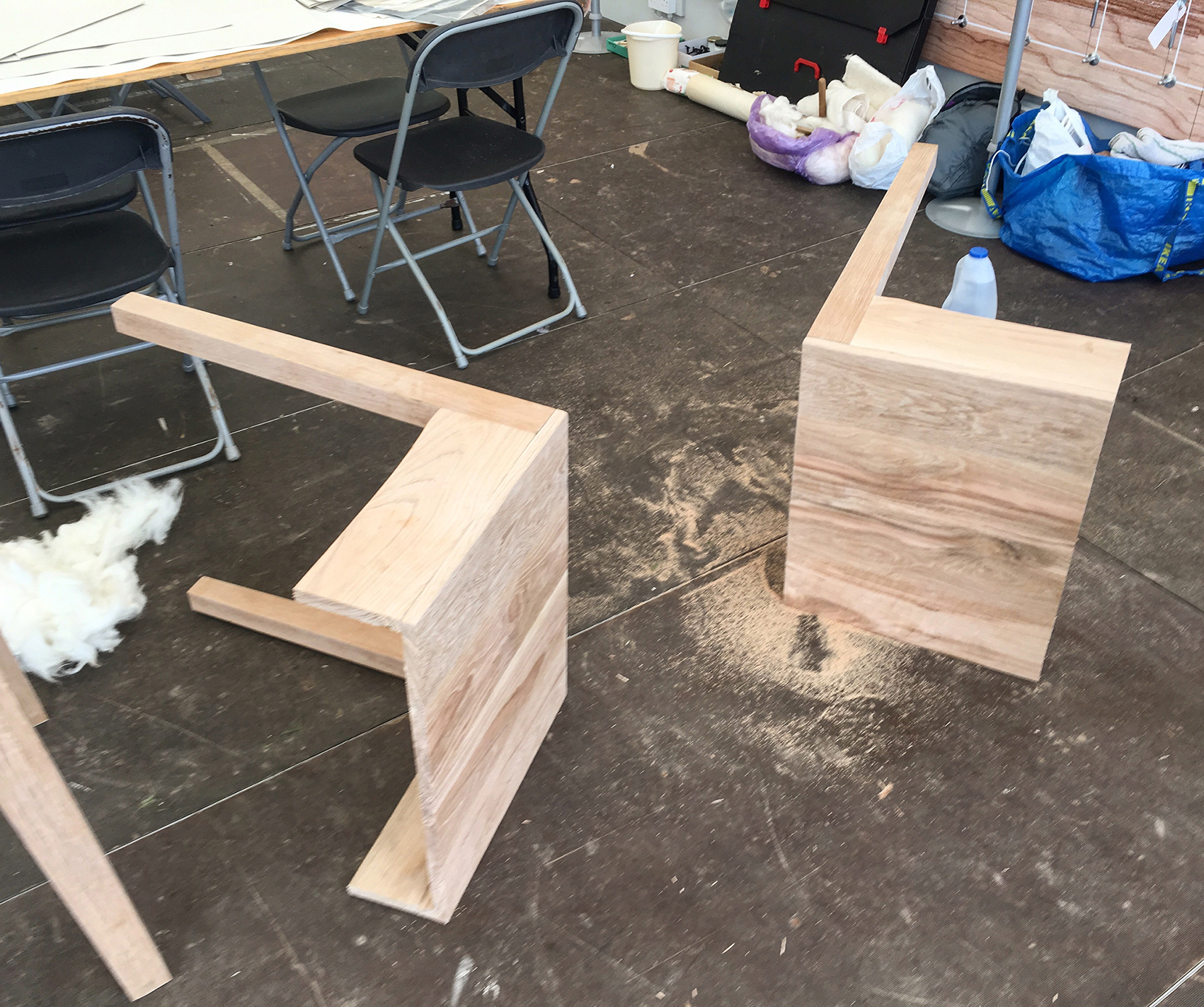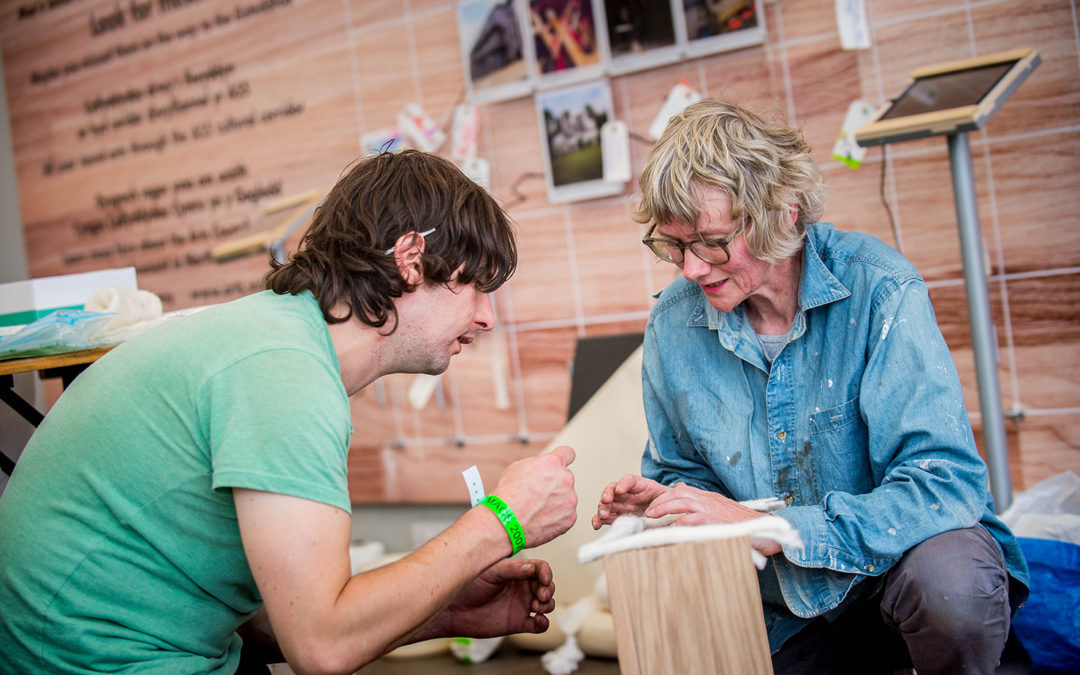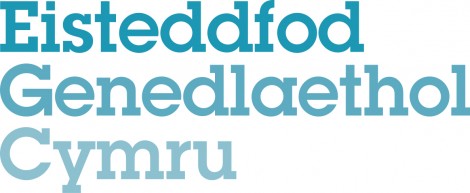Anrhydedd mawr oedd cynnal y gweithdy drop in mewn safle sy’n arddangos y gorau o gelf cyfoes Cymru, a gwych iawn oedd cael yr artist nodedig, rhyngwladol Christine Mills yn cyd-weithio i drawsnewid un o ddau fwrdd o’m gwaith “yn fyw” yn y fan a’r lle mewn diwrnod.

Roedd croeso i unrhyw un ymuno â’r sesiwn a chasglwyd nifer o syniadau a phrofiadau gan Eisteddfodwyr o bedwar ban byd. Profiad yr unigolyn a phrofiad bywyd grwpiau o bobol ydi’r prif syniad tu ôl i I’r Byw, a bydd y casgliad cyfa ar y diwedd o ddodrefn wedi, a heb eu trawsnewid, i’w weld ar daith o amgylch Cymru o ddiwedd Ebrill 2018 ymlaen.

Man cyfarfod ydi bwrdd efo nifer o benderfyniadau bach a mawr y byd wedi eu gwneud rhwng ffrindiau, cariadon a gelynion o amgylch y dodrefnyn syml yma.
“Mae yne rywbeth intimate iawn am fwrdd.” Meddai Christine Mills
“Yn yr achos yma lle i ddau sydd yna, a ma rywyn yn meddwl am arweinwyr gwledydd, a gwrthdaro, yn enwedig o gofio’r flwyddyn a chanrif ers marwolaeth Hedd Wyn a’r Gadair Ddu.”
Mae Christine yn defnyddio gwlân yn ei gwaith, gan creu creadigaethau fel Y Gorchudd Llwch oedd i’w weld yn Y Lle Celf eleni. Gorchudd enfawr oedd hwn wedi ei greu o wlân Yr Ysgwrn.
Yn ôl Sara Rhoslyn Moore yn Planet– “Mae’r gragen o’r Gadair Ddu ar ei blinth, yn atgoffa rhywun o orsedd, a’r angen i ddwyn y rheiny sydd mewn grym i gyfrif am fywydau a gollwyd yn uniongyrchol oherwydd eu penderfyniadau.”
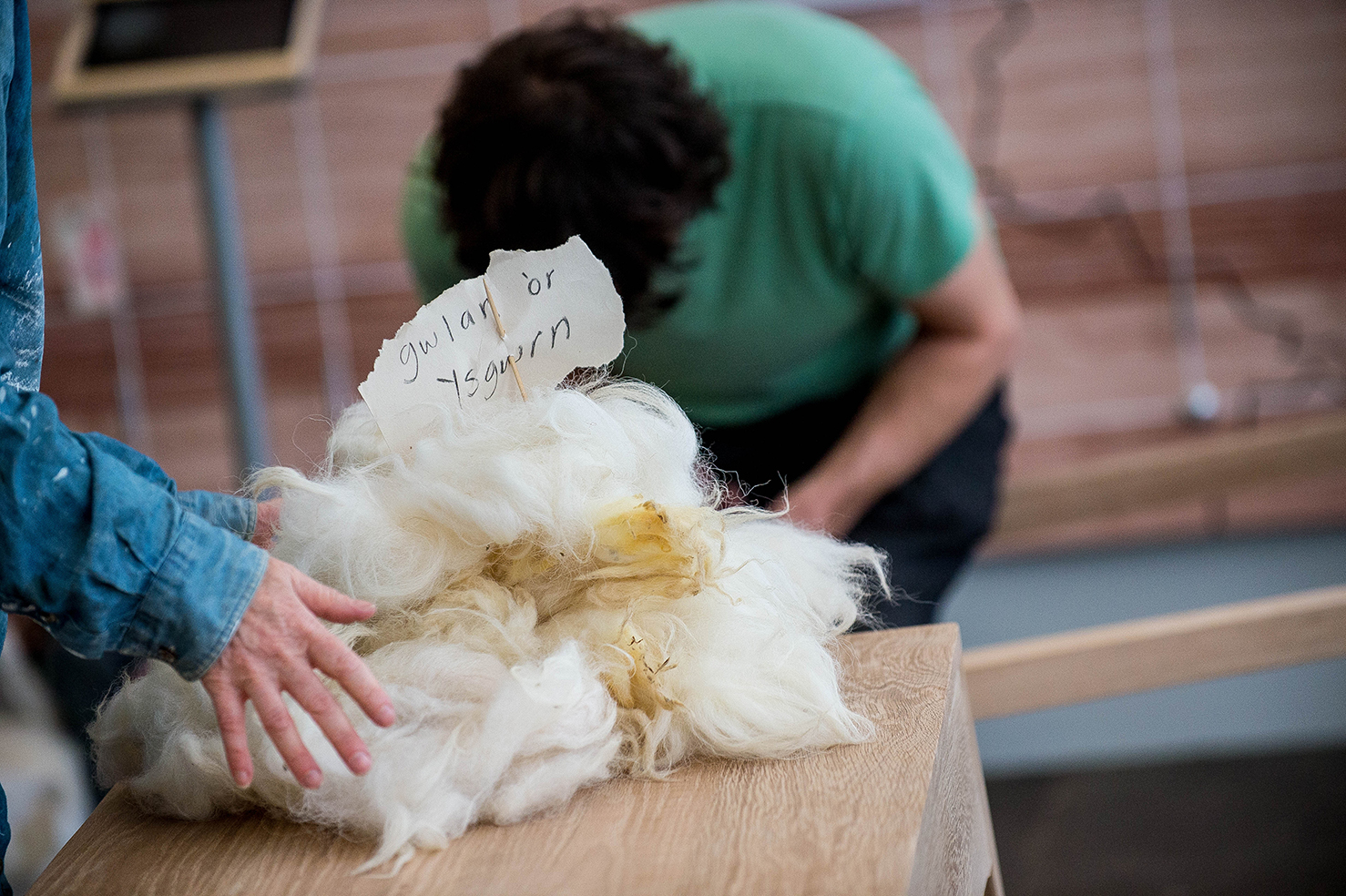
Roedd fy nyluniad ar gyfer Y Gadair yn 2017 yn cynnwys themau o aileni a symyd ymlaen o dywyllwch i oleuni, ond hefyd yn medru cael ei gweld fel cofgolofn i’r syniad o ddysgu o gamgymeriadau rhyfel.
Mi roedden ni felly yn dod at I’r Byw o gyfeiriadau eitha tebyg, ac roedd yn bwysig i ni fedru cyfarfod o amgylch y bwrdd derw, a’i ddefnyddio i’w bwrpas, i drafod ein syniadau. Yn yr achos yma, mi roedd y broses artistig ei hun yn rhan anatod o’r darn gorffenedig.
Drwy drafod a hel syniadau efo’n gilydd ac efo Eisteddfodwyr penderfynwyd ar lifio’r bwrdd yn ei hanner, a hynny wedyn yn cynnig posibiliadau eraill o weld y bwrdd wedi ei rannu yn ddau.
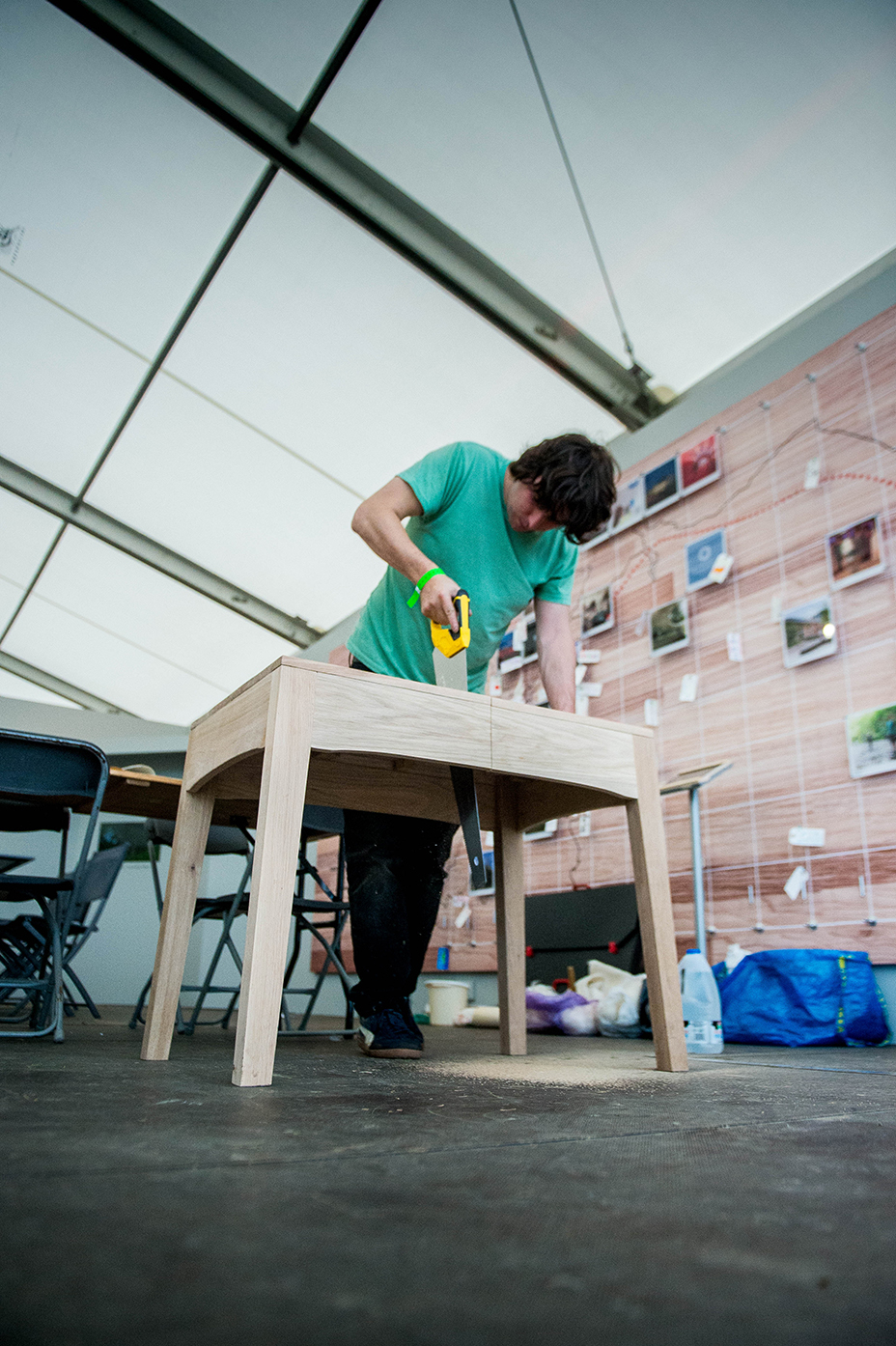
Gadawyd y ddau ddarn ynghanol y mwd ym Modedern tra ein bod yn trafod e.e. Eisteddfod Jamaica a sefydlwyd yno yn yr 1880au (sydd bellach wedi esblygu yn ŵyl fwy dan yr un enw), a hanes y wlad honno gydag aelodau o’r Jamaica Wales Alliance.

Tra bod cysylltiadau y ddwy wlad wedi dod yn wreiddiol o hanes tywyll iawn y sugarcane a choloneiddio Prydeinig, a’r diwydiant gwlân yng Nghymru yn dilladu caethweision yn Jamaica ac India’r Gorllewin, roedd yn bleser gweld cysylltiad positif â Chymru – un sy’n dathlu yn hytrach nag arwahanu ymhellach.
Unwyd y bwrdd unwaith eto ar ôl côt o inc du ar un o’r ddau hanner efo gwlân o’r Ysgwrn wedi ei ffeltio, yn ddolen lân, gysylltiadol rhwng y ddau. Mae’r inc yn broses a ddefnyddiwyd hefyd i gyfleu’r duwch ar Y Gadair, a gwych oedd medru cyfuno hyn â phroses ffeltio Christine o’r Gorchudd Llwch.

“Y dod yn ôl at ein gilydd sy’n bwysig” meddai Christine.
Tra bo dau berson, neu dwy ochor yn medru gwahanu neu ffraeo a mynd i gyfeiriadau gwahanol a chael profiadau gwahanol ar y daith, mae’n bwysig darganfod rhywbeth sy’n gyffredin i’w tynnu at ei gilydd unwaith eto. Boed hynny yn achos Jamaica a Chymru, cyfeillion a theuluoedd neu arweinwyr gwledydd mawr y byd.
It was a great honour to hold the drop in session at the temporary venue which annually hosts the best of Welsh art. It was also an honor to work with noted international artist Christine Mills to transform one of two table of my work live at Y Lle Celf in one day.

Anyone passing by were welcome to join in the session and we collected a number of ideas and experiences by Eisteddfodwyr from all over the world. The basis of the work is the experience of people and the lives of individuals, and the collection of changed and unchanged pieces of furniture from 8 locations will tour Wales from the end of April 2018.

A table is a meeting place were the world’s decisions, both important and less important, between friends, lovers and enemies are made around this simple piece of furniture.
“There’s something very intimate about a table” says Christine Mills
“In this case, there’s a place for two people, and I’m drawn to think of national leaders, and conflict, especialy while remembering 2017 as the year of the centenery of the death of Hedd Wyn and Y Gadair Ddu.”
Christine uses felted wool in her work, creating works like Y Gorchudd Llwch (trans..The Dust Cover) which was exhibited at Y Lle Celf. This was a large felted sheet from wool taken from the sheep at Yr Ysgwrn.
According to Sara Rhoslyn Moore in Planet – “Christine Mills responds to the centenary of Hedd Wyn’s death with her sculpture made of wool and well-water from Yr Ysgwrn, Trawsfynydd, the poet’s home. Mills’ ghostly white shell of the black chair on its plinth, comparable to a throne, reminds us of the need to hold the powerful to account for lives lost in pursuit of their power games.”
My design for the 2017 National Eisteddfod Chair includes themes of rebirth and moving forward but it can in some respect be seen as a monument to the idea of learning from the mistakes of war.
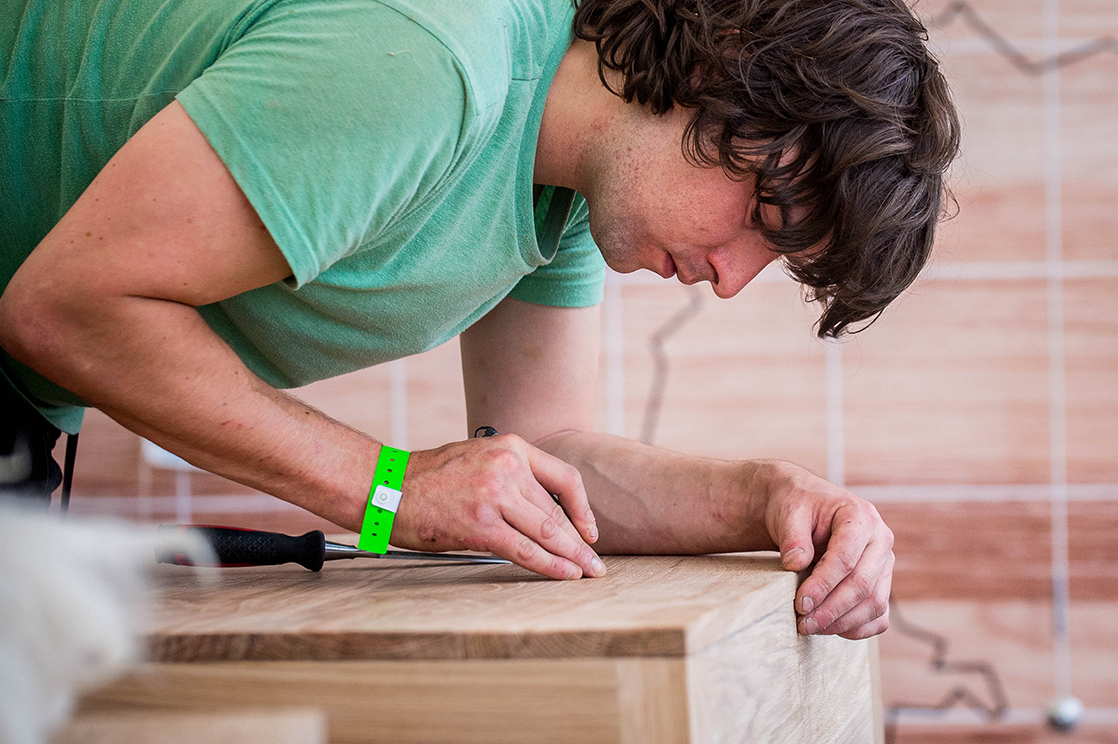
We were coming towards I’r Byw from quite similar directions then, and it was important for us to meet facing each other around the table to discuss our ideas. In this case, the artistic process itself is part of the finished piece.
By discussing and collecting ideas together and with Eisteddfodwyr, we decided to saw the oak table in half, which then lent itself to further possibilities on seeing the table in two parts.
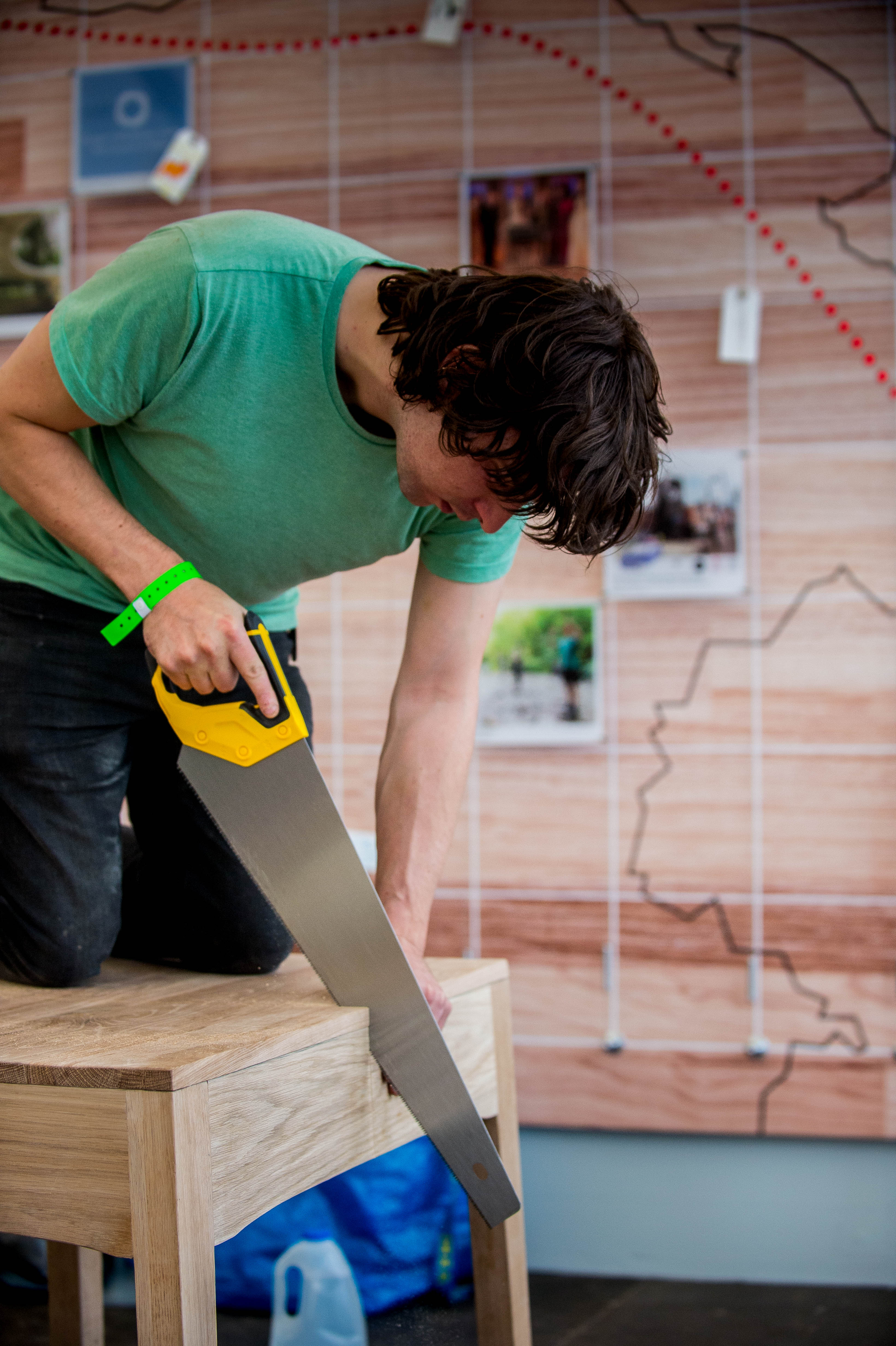
We left the table in the Bodedern mud while we discussed the Jamaican Eisteddfod (est. 1880s) and the history of that country with members of the Jamaica Wales Alliance.

While the connection between the two countries is steeped in the dark history of sugarcane and British colonialism, with the Welsh woolen industry primarily responsible for clothing West Indian slaves, it was a pleasure to see a positive connection with Wales – one that celebrates the good and creates an union for the future.
We rejoined both sides of the table after a coat of black ink on one side, with a clean block of Yr Ysgwrn wool, a connecting link between the two sides. The ink is a process I used on The Chair, and it was great to combine this process with Christine’s felt from Y Gorchudd Llwch.

“It’s the coming back together that’s important” says Christine.
While two people, or two sides can separate or fall out and go in different directions and have different experiences on their separate journeys form the same starting point it’s important to find something in common despite the differences. Wether that’s in the case of Jamaica and Wales, or the world’s leaders.
.
.
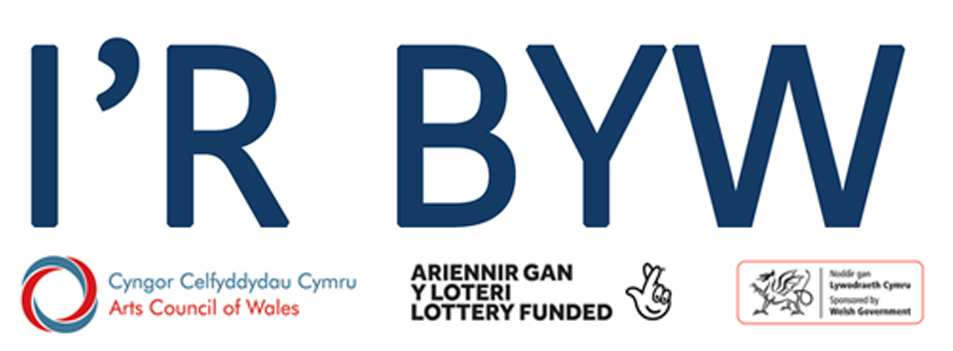
.
.
